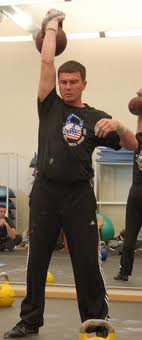So, these last few weeks I have been having a bit of a disagreement with a client of mine. He has the fixed notion that he shouldn’t “go heavy” in presses, and doesn’t want to swing single handed, preferring to stick with his double-hand swing. He’s worried that his back “will go” or an old shoulder problem might flare up.
The reality is that a well-performed press, using a steady increase in weights, will serve to give him strength in his back and shoulder, not diminish it. I am in fact much more concerned with his propensity to go for speed in presses. This is a difficult exercise to achieve at speed, as usually technique will suffer, and poorly executed reps do not benefit the lifter, and can in fact be detrimental. I have been trying to get him to focus on achieving the best press he can each time, so slowing him down to 8-10rpm, just so that he is taking his time over each press. Talking this week to Coach Valery Fedorenko, he described how he was himself working through a painful lift to pinpoint the motion that sparks it off. I could see how this world champion knew precisely how to work through a dysfunction and come out on the other side with a stronger lift. He saw no need to avoid the range of movement, could appreciate that doing nothing would change nothing. Nor did he want to rush the motion, but valued taking it really steadily.
My second gripe, I guess, is the notion that a back “goes” and we must avoid certain movements to escape that horror. I want my client to be bold, and work on his flexibility and mobility as a positive response to these spasms. The more we retract and limit our movements, the more vulnerable we will become. We need to reclaim pushing, pulling and lifting in all three planes, to keep us strong.
My third point of contention is the double hand swing argument: it’s not protecting his shoulder, it’s masking any weaknesses, so the disparity between one side and the other is only growing. If he swings single hand, he will discover his limits absolutely, and we can work from that knowledge base. Double hand, we are only surmising which arm is taking the brunt of the action.
Ah well, my client has agreed to “play it my way” next week, so let’s see what can be accomplished when client and coach work together!

